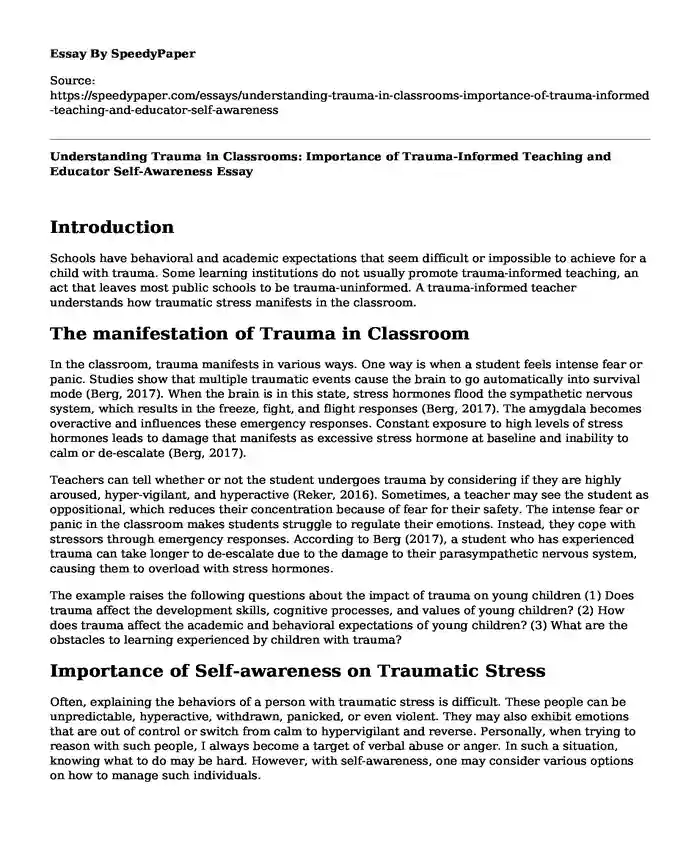Introduction
Schools have behavioral and academic expectations that seem difficult or impossible to achieve for a child with trauma. Some learning institutions do not usually promote trauma-informed teaching, an act that leaves most public schools to be trauma-uninformed. A trauma-informed teacher understands how traumatic stress manifests in the classroom.
The manifestation of Trauma in Classroom
In the classroom, trauma manifests in various ways. One way is when a student feels intense fear or panic. Studies show that multiple traumatic events cause the brain to go automatically into survival mode (Berg, 2017). When the brain is in this state, stress hormones flood the sympathetic nervous system, which results in the freeze, fight, and flight responses (Berg, 2017). The amygdala becomes overactive and influences these emergency responses. Constant exposure to high levels of stress hormones leads to damage that manifests as excessive stress hormone at baseline and inability to calm or de-escalate (Berg, 2017).
Teachers can tell whether or not the student undergoes trauma by considering if they are highly aroused, hyper-vigilant, and hyperactive (Reker, 2016). Sometimes, a teacher may see the student as oppositional, which reduces their concentration because of fear for their safety. The intense fear or panic in the classroom makes students struggle to regulate their emotions. Instead, they cope with stressors through emergency responses. According to Berg (2017), a student who has experienced trauma can take longer to de-escalate due to the damage to their parasympathetic nervous system, causing them to overload with stress hormones.
The example raises the following questions about the impact of trauma on young children (1) Does trauma affect the development skills, cognitive processes, and values of young children? (2) How does trauma affect the academic and behavioral expectations of young children? (3) What are the obstacles to learning experienced by children with trauma?
Importance of Self-awareness on Traumatic Stress
Often, explaining the behaviors of a person with traumatic stress is difficult. These people can be unpredictable, hyperactive, withdrawn, panicked, or even violent. They may also exhibit emotions that are out of control or switch from calm to hypervigilant and reverse. Personally, when trying to reason with such people, I always become a target of verbal abuse or anger. In such a situation, knowing what to do may be hard. However, with self-awareness, one may consider various options on how to manage such individuals.
Self-awareness allows me to see myself clearly and objectively through reflection and introspection. With this attribute, I can understand what the child is going through and make decisions in managing those challenges. For instance, in one scenario, a teacher may see a troubled child deliberately disobeying school rules. In this case, the trauma-uninformed teacher may subject the teacher to punishment or suspension. However, self-awareness can help me see that child as an activated student struggling to self-regulate and manage his emotions. Because I am trauma informed, I could support the child and help him overcome his condition. In other words, my-self-assessment is important because it helps me understand children with trauma and support to manage their conditions.
Conclusion
In the classroom, trauma can manifest through fear or panic exhibited by students. Such children cannot control their emotions. Instead, they employ emergency responses to cope up with stressors. Self-awareness helps in understanding such children and helping them overcome their situation.
References
Berg, A. E. (2017). Trauma in schools: Identifying and working with students who have experienced trauma.Retrieved from https://ir.stthomas.edu/ssw_mstrp/711/
Reker, K. (2016). Trauma in the Classroom: Teachers' perspectives on supporting students experiencing child traumatic stress.Retrieved from https://ecommons.luc.edu/luc_diss/2146/
Cite this page
Understanding Trauma in Classrooms: Importance of Trauma-Informed Teaching and Educator Self-Awareness. (2023, Dec 30). Retrieved from https://speedypaper.com/essays/understanding-trauma-in-classrooms-importance-of-trauma-informed-teaching-and-educator-self-awareness
Request Removal
If you are the original author of this essay and no longer wish to have it published on the SpeedyPaper website, please click below to request its removal:
- Inspiration to Write My Paper. Free Essay Sample.
- Professional Development for Teachers, Free Essay Sample
- Paper Example. Review of Research Articles
- Free Essay Sample: The Common Oxidizers in the Scenario
- Paper Example: Why I Want to Become a Warrant Officer in the US Marine Corps
- The Productivity Puzzle. Paper Example
- Free Essay Sample - Motivational Structure
Popular categories





